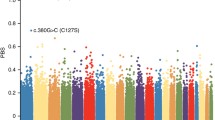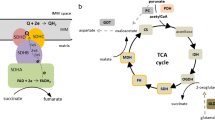Abstract
Hereditary paraganglioma type 1 (PGL1) is characterized by slow-growing and vascularized tumors that often develop in the carotid body (CB) and is caused by mutations in the gene for succinate dehydrogenase D (SDHD) of mitochondrial complex II. The mechanisms of tumorigenesis and the factors affecting penetrance and expressivity are unknown. Because chronic hypoxic stimulation at high altitudes causes sporadic CB paragangliomas, it has been hypothesized that the SDHD gene product may be involved in oxygen sensing. On this background, we examined genotype-phenotype-environment relationships and tested whether higher altitudes adversely affect the phenotype in PGL1. An analysis of 58 subjects from 23 families revealed that nonsense/splicing mutation carriers developed symptoms 8.5 years earlier than missense mutation carriers (P<0.012). We also found that subjects who were diagnosed with single tumors at their first clinical evaluation lived at lower average altitudes and were exposed to lower altitude-years than those with multiple tumors (P<0.012). Pheochromocytomas developed in six subjects (approximately 10%), five of whom had nonsense mutations (P=0.052). Subjects with pheochromocytomas also lived at higher average altitudes and were exposed to higher altitude-years than those without them (P=0.026). To test whether altitude is also associated with the more frequent detection of germ-line founder mutations among sporadic cases in The Netherlands than in the USA (P=0.00033), we calculated population-weighted elevations of the two countries. We found that the population-weighted elevations were approximately 260 m for the US and 2 m for the central-western Netherlands (P~0), where three Dutch founder mutations were discovered. This finding suggests that low altitudes in The Netherlands reduce penetrance and relax the natural selection on SDHD mutations. Collectively, these data suggest that higher altitudes and nonsense/splicing mutations are associated with phenotypic severity in PGL1 and support the hypothesis that SDHD mutations impair oxygen sensing.

Similar content being viewed by others
References
Arias-Stella J, Valcarcel J (1976) Chief cell hyperplasia in the human carotid body at high altitudes; physiologic and pathologic significance. Hum Pathol 7:361–373
Astuti D, Douglas F, Lennard TW, Aligianis IA, Woodward ER, Evans DG, Eng C, Latif F, Maher ER (2001a) Germline SDHD mutation in familial phaeochromocytoma. Lancet 357:1181–1182
Astuti D, Latif F, Dallol A, Dahia PL, Douglas F, George E, Skoldberg F, Husebye ES, Eng C, Maher ER (2001b) Gene mutations in the succinate dehydrogenase subunit SDHB cause susceptibility to familial pheochromocytoma and to familial paraganglioma. Am J Hum Genet 69:49–54
Badenhop RF, Cherian S, Lord RS, Baysal BE, Taschner PE, Schofield PR (2001) Novel mutations in the SDHD gene in pedigrees with familial carotid body paraganglioma and sensorineural hearing loss. Genes Chromosome Cancer 31:255–263
Baysal BE (2001) Genetics of familial paragangliomas: past, present, and future. Otolaryngol Clin North Am 34:863–79
Baysal BE (2002) Hereditary paraganglioma targets diverse paraganglia. J Med Genet 39:617–622
Baysal BE, Farr JE, Rubinstein WS, Galus RA, Johnson KA, Aston CE, Myers EN, Johnson JT, Carrau R, Kirkpatrick SJ, Myssiorek D, Singh D, Saha S, Gollin SM, Evans GA, James MR, Richard CW III (1997) Fine mapping of an imprinted gene for familial nonchromaffin paragangliomas, on chromosome 11q23. Am J Hum Genet 60:121–132
Baysal BE, Schothorst EM van, Farr JE, Grashof P, Myssiorek D, Rubinstein WS, Taschner P, Cornelisse CJ, Devlin B, Devilee P, Richard CW (1999) Repositioning the hereditary paraganglioma critical region on chromosome band 11q23. Hum Genet 104:219–225
Baysal BE, Ferrell RE, Wilett-Brozick JE, Lawrence EC, Myssiorek D, Bosch A, Mey A van der, Taschner PEM, Rubinstein WS, Myers EN, Richard CW III, Cornelisse CJ, Devilee P, Devlin B (2000) Mutations in SDHD, a mitochondrial complex II gene, in hereditary paraganglioma. Science 287:848–851
Baysal BE, Willett-Brozick JE, Lawrence EC, Drovdlic CM, Savul SA, McLeod DR, Yee HA, Brackmann DE, Slattery WH III, Myers EN, Ferrell RE, Rubinstein WS (2002) Prevalence of SDHB, SDHC, and SDHD germline mutations in clinic patients with head and neck paragangliomas. J Med Genet 39:178–183
Cascon A, Ruiz-Llorente S, Cebrian A, Telleria D, Rivero JC, Diez JJ, Lopez-Ibarra PJ, Jaunsolo MA, Benitez J, Robledo M (2002) Identification of novel SDHD mutations in patients with phaeochromocytoma and/or paraganglioma. Eur J Hum Genet 10:457–461
Chandel NS, Schumacker PT (2000) Cellular oxygen sensing by mitochondria: old questions, new insight. J Appl Physiol 88:1880–1889
Cohen JE, Small C (1998) Hypsographic demography: the distribution of human population by altitude. Proc Natl Acad Sci USA 95:14009–14014
Cremers CW, De Monnink JP, Arts N, Joosten FB, Kremer H, Hoefsloot L (2002) Clinical report on the L95P mutation in a Dutch family with paraganglioma. Otol Neurotol 23:755–759
Dannenberg H, Dinjens WN, Abbou M, Van Urk H, Pauw BK, Mouwen D, Mooi WJ, Krijger RR de (2002) Frequent germ-line succinate dehydrogenase subunit D gene mutations in patients with apparently sporadic parasympathetic paraganglioma. Clin Cancer Res 8:2061–2066
Gimenez-Roqueplo AP, Favier J, Rustin P, Mourad JJ, Plouin PF, Corvol P, Rotig A, Jeunemaitre X (2001) The R22X mutation of the SDHD gene in hereditary paraganglioma abolishes the enzymatic activity of complex II in the mitochondrial respiratory chain and activates the hypoxia pathway. Am J Hum Genet 69:1186–1197
Gimm O, Armanios M, Dziema H, Neumann HP, Eng C (2000) Somatic and occult germ-line mutations in SDHD, a mitochondrial complex II gene, in nonfamilial pheochromocytoma. Cancer Res 60:6822–6825
Gonzalez C, Almaraz L, Obeso A, Rigual R (1994) Carotid body chemoreceptors: from natural stimuli to sensory discharges. Physiol Rev 74:829–898
Hederstedt L (2003) Structural biology. Complex II is complex too. Science 299:671–672
Heutink P, Mey AG van der, Sandkuijl LA, Gils AP van, Bardoel A, Breedveld GJ, Vliet M van, Ommen GJ van, Cornelisse CJ, Oostra BA, Weber JL, Devilee P (1992) A gene subject to genomic imprinting and responsible for hereditary paragangliomas maps to chromosome 11q23-qter. Hum Mol Genet 1:7–10
Ishii N, Fujii M, Hartman PS, Tsuda M, Yasuda K, Senoo-Matsuda N, Yanase S, Ayusawa D, Suzuki K (1998) A mutation in succinate dehydrogenase cytochrome b causes oxidative stress and ageing in nematodes. Nature 394:694–697
Lancaster CRD (2002) Special issue on Bioenergetics. Biochim Biophys Acta 1320:1–176
Mariman ECM, Beersum SEC van, Cremers CWRJ, Baars FM van, Ropers HH (1993) Analysis of a second family with hereditary non-chromaffin paragangliomas locates the underlying gene at the proximal region of chromosome 11q. Hum Genet 91:357–361
Maxwell PH, Wiesener MS, Chang GW, Clifford SC, Vaux EC, Cockman ME, Wykoff CC, Pugh CW, Maher ER, Ratcliffe PJ (1999) The tumour suppressor protein VHL targets hypoxia-inducible factors for oxygen-dependent proteolysis. Nature 399:271–275
Messner KR, Imlay JA (2002) Mechanism of superoxide and hydrogen peroxide formation by fumarate reductase, succinate dehydrogenase, and aspartate oxidase. J Biol Chem 277:42563–42571
Mey AG van der, Maaswinkel-Mooy PD, Cornelisse CJ, Schmidt PH, Kamp JJ van de (1989) Genomic imprinting in hereditary glomus tumours: evidence for new genetic theory. Lancet II:1291–1294
Milunsky JM, Maher TA, Michels VV, Milunsky A (2001) Novel mutations and the emergence of a common mutation in the SDHD gene causing familial paraganglioma. Am J Med Genet 100:311–314
Neumann HP, Bausch B, McWhinney SR, Bender BU, Gimm O, Franke G, Schipper J, Klisch J, Altehoefer C, Zerres K, Januszewicz A, Smith WM, Munk R, Manz T, Glaesker S, Apel TW, Treier M, Reineke M, Walz MK, Hoang-Vu C, Brauckhoff M, Klein-Franke A, Klose P, Schmidt H, Maier-Woelfle M, Peczkowska M, Szmigielski C, Eng C (2002) Germ-line mutations in nonsyndromic pheochromocytoma. N Engl J Med 346:1459–1466
Niemann S, Muller U (2000) Mutations in SDHC cause autosomal dominant paraganglioma, type 3. Nat Genet 26:268–270
Renard L, Godfraind C, Boon LM, Vikkula M (2003) A novel mutation in the SDHD gene in a family with inherited paragangliomas-implications of genetic diagnosis for follow up and treatment. Head Neck 25:146–151
Schothorst EM van, Jansen JC, Grooters E, Prins DE, Wiersinga JJ, Mey AG van der, Ommen GJ van, Devilee P, Cornelisse CJ (1998) Founder effect at PGL1 in hereditary head and neck paraganglioma families from The Netherlands. Am J Hum Genet 63:468–473
Senoo-Matsuda N, Yasuda K, Tsuda M, Ohkubo T, Yoshimura S, Nakazawa H, Hartman PS, Ishii N (2001) A defect in the cytochrome b large subunit in complex II causes both superoxide anion overproduction and abnormal energy metabolism in Caenorhabditis elegans. J Biol Chem 276:41553–41558
Taschner PE, Jansen JC, Baysal BE, Bosch A, Rosenberg EH, Brocker-Vriends AH, Mey AG van der, Ommen GJ van, Cornelisse CJ, Devilee P (2001) Nearly all hereditary paragangliomas in The Netherlands are caused by two founder mutations in the SDHD gene. Genes Chromosome Cancer 31:274–281
West JB (1996) Prediction of barometric pressures at high altitude with the use of model atmospheres. J Appl Physiol 81:1850–1854
Yankovskaya V, Horsefield R, Tornroth S, Luna-Chavez C, Miyoshi H, Leger C, Byrne B, Cecchini G, Iwata S (2003) Architecture of succinate dehydrogenase and reactive oxygen species generation. Science 299:700–704
Acknowledgements
We thank all PGL1 subjects for their help; this study would not have been possible without their participation. We also thank Drs. E.N. Myers, E. Böke, E.C. Ridgway, R.A. Spritz for referring patients, Dr. R.E. Ferrell and Mrs. E.C. Lawrence for help in sequencing family PGL20, Dr. Myers for stipend support to K.A, and Dr. W.S. Rubinstein for helpful discussions. J.E.C. thanks the US NSF for grant DEB9981552 and Mr. and Mrs. W.T. Golden for hospitality during this work.
Author information
Authors and Affiliations
Corresponding author
Rights and permissions
About this article
Cite this article
Astrom, K., Cohen, J.E., Willett-Brozick, J.E. et al. Altitude is a phenotypic modifier in hereditary paraganglioma type 1: evidence for an oxygen-sensing defect. Hum Genet 113, 228–237 (2003). https://doi.org/10.1007/s00439-003-0969-6
Received:
Accepted:
Published:
Issue Date:
DOI: https://doi.org/10.1007/s00439-003-0969-6




